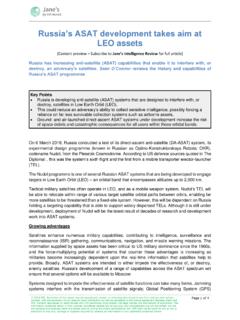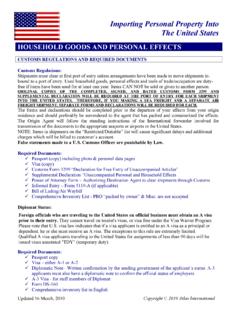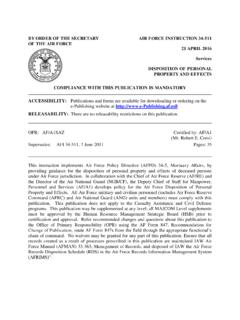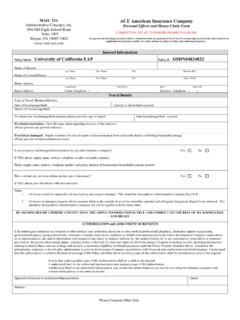Transcription of Personal effects: Assault rifles and small- arms …
1 2018 IHS. No portion of this report may be reproduced, reused, or otherwise distributed in any form without prior written consent, with the exception of any internal client distribution as may be permitted in the license agreement between client and IHS. Content reproduced or redistributed with IHS permission must display IHS legal notices and attributions of authorship. The information contained herein is from sources considered reliable but its accuracy and completeness are not warranted, nor are the opinions and analyses which are based upon it, and to the extent permitted by law, IHS shall not be liable for any errors or omissions or any loss, damage or expense incurred by reliance on information or any statement contained herein. Page 1 of 4 Personal effects: Assault rifles and small- arms technology [Content preview Subscribe to Jane s Defence Weekly for full article] Responding to the requirements arising out of an increasingly complex operating environment, international armed forces are finally witnessing the gradual proliferation of alternative weapon and ammunition designs aimed at improving the mobility, precision, and lethality of soldiers on the battlefield.
2 Andrew White reports Recent developments in small arms technology include the introduction of shorter-barrelled rifles and carbines for close quarter battle (CQB) and Personal defence weapon roles; alternative calibre cartridges designed to optimise weight and lethality ratios; the spread of suppressor technology for enhanced signature management; and the fielding of integrated fire control systems (FCSs) for improved accuracy at the lowest tactical level. Operational requirements for such systems were considered at the Future Soldier Technology conference in London on 13 March, where senior service officials from across NATO warned of the emerging capabilities of peer and near-peer adversaries, particularly in areas relating to lethality and survivability. IWI has designed the Tavor 7 in the heavier mm calibre to respond to ongoing requirements from special mission units for increased stopping power. The weapon was designed with input from the IDF s special operations community.
3 (IWI) 1721685 2018 IHS. No portion of this report may be reproduced, reused, or otherwise distributed in any form without prior written consent, with the exception of any internal client distribution as may be permitted in the license agreement between client and IHS. Content reproduced or redistributed with IHS permission must display IHS legal notices and attributions of authorship. The information contained herein is from sources considered reliable but its accuracy and completeness are not warranted, nor are the opinions and analyses which are based upon it, and to the extent permitted by law, IHS shall not be liable for any errors or omissions or any loss, damage or expense incurred by reliance on information or any statement contained herein. Page 2 of 4 Examples that sources highlighted to Jane s included the enhanced armour penetration and protection solutions now available to opponents in China, Iran, North Korea, and Russia, as well as similar but less well-advanced capabilities now available to non-state actors and violent extremist organisations.
4 Such capabilities include upgrades to Personal protection equipment and vehicle protection kits, which are designed to increase the survivability of troops on the ground; and armour-piercing ammunition and Assault rifle technology that provide special operations forces and dismounted close combat personnel with increasing levels of precision and lethality. However, referring to these emerging requirements, Daryl Easlick, Deputy Director of the US Army Lethality Branch, explained how any increase in the penetration effects of existing small- arms solutions, achieved through higher levels in barrel pressure, must be delicately balanced with emerging demands to reduce the acoustic and physical signatures of weapon systems. If I pump the [barrel] pressure up, I m killing myself with signature and recoil management. It s going to be difficult, Easlick warned while describing how acoustic and physical signatures of small arms could assist enemy forces in detecting, identifying, and neutralising threats.
5 This is one of the strongest arguments for increasing the use of suppressor technology across conventional armed forces, especially those operating in urban and subterranean environments where weapon signatures can be amplified in confined spaces. Meanwhile, Easlick also described emerging requirements to more effectively engage peer and near-peer targets at extended ranges, describing ongoing efforts to design laser rangefinders and ballistic calculators that could disturb the reticles of Assault rifles and carbines at the lowest tactical edge to enhance lethality and precision. Such a capability has traditionally remained the preserve of more specialist sniper rifles , where technology including laser rangefinders, ballistic calculators, and integrated FCSs can measure environmental effects to maximise the probability of a first-round hit. Modern enhancements As armed forces continue to identify and develop various next-generation upgrades, short- to medium-term improvements in Assault rifle and carbine technology look set to focus on reduced form factors and alternative calibre types for more effective operation in confined areas, which is particularly relevant to urban environments.
6 This follows the ongoing focus on operations undertaken in subterranean environments and megacities by the likes of the US Army and Israel Defense Force (IDF), where special forces and dismounted close combat teams can be heavily engaged in CQB. For example, the US Special Operations Command (USSOCOM) is considering multiple approaches to the calibre debate and evaluation of mm and .260 Remington ammunition through to mm and .270 Winchester rounds is continuing. However, some of the most innovative small- arms solutions have been adopted by the Netherlands Maritime Special Operations Force (NL MARSOF), which became one of the first organisations to adopt .300 calibre Blackout (300 BLK) rounds. In November 2016 the NL MARSOF confirmed its decision to procure 195 MCX carbines from Sig Sauer in 300 BLK as part of its wider consideration 2018 IHS. No portion of this report may be reproduced, reused, or otherwise distributed in any form without prior written consent, with the exception of any internal client distribution as may be permitted in the license agreement between client and IHS.
7 Content reproduced or redistributed with IHS permission must display IHS legal notices and attributions of authorship. The information contained herein is from sources considered reliable but its accuracy and completeness are not warranted, nor are the opinions and analyses which are based upon it, and to the extent permitted by law, IHS shall not be liable for any errors or omissions or any loss, damage or expense incurred by reliance on information or any statement contained herein. Page 3 of 4 of a wholesale change in calibre from its in-service armoury of Heckler & Koch HK416 rifles in NATO standard mm calibre. Comprising a mm projectile contained in the casing of legacy mm ammunition, the 300 BLK calibre provides significant uplift in lethality, range, and precision levels over mm rounds without any significant increase in weight carried by personnel. However, on 7 February the Dutch Ministry of Defence (MoD) announced a EUR14 million ( million) contract to acquire an undisclosed number of HK416 A5 carbines during a seven-year period, signalling the intention of the NL MARSOF and the army s Korps Commandotroepen (KCT) to continue operating mm carbines as a primary weapon in the near-to-medium term.
8 Meanwhile, the international community is keeping a close eye on the United States regarding alternative weapon and ammunition designs. On 1 March the US Army unveiled a prototype opportunity notice for its Next-Generation Squad Automatic Rifle (NGSAR) programme, which could have significant implications for the small- arms inventory of the US armed forces and the international community. The NGSAR programme is being undertaken to find a suitable alternative to the army s mm M249 Squad Automatic Weapon (SAW) with an Assault rifle form factor to combine the firepower and range of a machine gun with the precision and ergonomics of a rifle, yielding capability improvements in accuracy, range, and lethality , according to an official solicitation document. The prototype opportunity notice stipulated how the NGSAR weapon must comprise a lightweight platform capable of firing lightweight ammunition to improve soldier mobility, survivability, and precision.
9 According to the solicitation, the NGSAR programme aims to identify solutions at technology readiness level (TRL) 6 with a view to contracting up to three technology demonstrator prototypes. Following an evaluation programme this will be reduced to two competitors in a production and deployment phase, with the army highlighting its desire to procure more than 15,000 weapons, associated FCSs, and more than 30 million rounds of lightweight ammunition. Programme requirements call for a weapon system weighing no more than 12 lb ( kg), providing warfighters with 20% weight savings over legacy solutions. The NGSAR must also measure no more than 35 inches (889 mm) long with weapon stock fully extended, the solicitation explained. Additionally, the NGSAR programme is seeking a dedicated FCS to support laser rangefinding and ballistic calculation in a single form factor weighing no more than 3 lb ( kg). The NGSAR barrel must also retain the capacity to feature suppressor technology for acoustic and visual signature management.
10 [Continued in full ] (1008 of 3254 words) 2018 IHS. No portion of this report may be reproduced, reused, or otherwise distributed in any form without prior written consent, with the exception of any internal client distribution as may be permitted in the license agreement between client and IHS. Content reproduced or redistributed with IHS permission must display IHS legal notices and attributions of authorship. The information contained herein is from sources considered reliable but its accuracy and completeness are not warranted, nor are the opinions and analyses which are based upon it, and to the extent permitted by law, IHS shall not be liable for any errors or omissions or any loss, damage or expense incurred by reliance on information or any statement contained herein. Page 4 of 4 For the full version and more content: For advertising solutions visit Jane s Advertising Jane's Defence Industry and Markets Intelligence Centre This analysis is taken from Jane s Defence Industry & Markets Intelligence Centre, which provides world-leading analysis of commercial, industrial and technological defence developments, budget and programme forecasts, and insight into new and emerging defence markets around the world.













